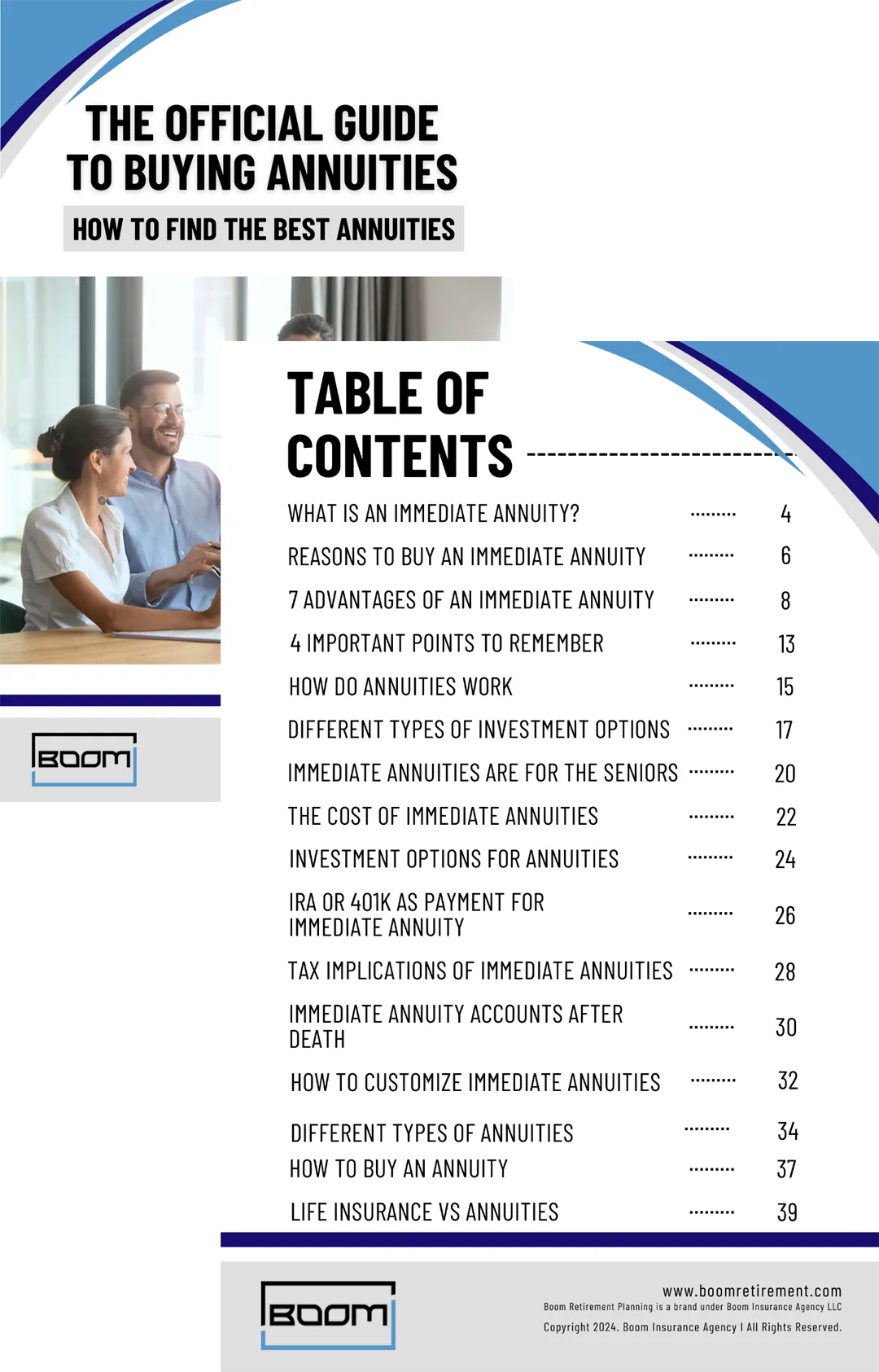
BOOM RETIREMENT SOLUTIONS
Strategies for Boosting Retirement Income

Top Retirement Cash Flow Risks
Why you need this Retirement Toolkit
Will outlive your retirement savings?
Will taxes and inflation erode your Retirement Nest Egg?
Will you head into retirement using an Accumulation Strategy or a Decumulation Strategy?
Will you maintain your lifestyle in a market downturn?
Are you prepared for RMD's and IRMAA?
BOOM RETIREMENT PLANNING
Strategies for Boosting Retirement Income
If You Ask 50 Financial Advisors,
"What is the best way to retire?".
You will get 50 different answers!
That is because despite all their training and certifications,
financial advisors each bring their own perspectives, experiences, and
biases to the table, leading to varied approaches and strategies tailored to their
unique understanding of the market, client needs, and risk tolerance.
Economic Science and Math proves...
There is Only One Optimal Way to Retire
Over 6 Decades of Research Created the 7 Steps Below.
Develop a Plan: Assess your financial situation, retirement goals, income sources and monthly budget for expenses.
Secure Lifetime Income: Consider products like private pensions for guaranteed income.
Maximize Social Security: Optimize benefits by understanding your options; delaying to 67 or 70 can help.
Diversify Investments: Build a balanced portfolio—30% cash value life insurance, 30% lifetime income, 40% growth assets.
Prepare for Health Care Costs: Budget for health expenses, including long-term care, which most seniors will need.
Use Tax-Efficient Strategies: Consider Roth conversions to reduce retirement taxes.
Stay Active and Engaged: Pursue activities for mental, physical, and emotional well-being in retirement.
Our Blog

Reset Methods for Fixed Indexed Annuities: A Comprehensive Guide
Reset Methods for Fixed Indexed Annuities: A Comprehensive Guide
Fixed Indexed Annuities (FIAs) are a popular financial product for individuals seeking a balance between potential growth and principal protection. One critical feature of FIAs that can significantly impact the returns is the reset method. Understanding how reset methods work and their implications can help investors make informed decisions. This comprehensive guide explores the different types of reset methods, their benefits and drawbacks, and how they influence the performance of Fixed Indexed Annuities.
What Are Fixed Indexed Annuities (FIAs)?
Fixed Indexed Annuities are insurance products that offer interest earnings based on the performance of a specified market index, such as the S&P 500. Unlike direct investments in the stock market, FIAs provide a level of protection against market downturns while still allowing for potential gains during market upswings. The credited interest in an FIA is determined by the index's performance, subject to certain limitations like cap rates, participation rates, spreads, and reset methods.
Understanding Reset Methods
Reset methods in FIAs determine how often and in what manner the performance of the chosen index is measured and credited to the annuity. The reset method is crucial because it affects how gains are locked in and how the index performance is tracked over time. There are primarily three reset methods: Annual Reset (Point-to-Point), High-Water Mark, and Monthly Averaging.
1. Annual Reset (Point-to-Point)
Definition: The Annual Reset, also known as the Point-to-Point method, measures the index's performance from the start of the year to the end of the year. The interest credited is based on the difference between the index value at the beginning and the end of the year.
How It Works:
Start Value: The index value at the beginning of the period.
End Value: The index value at the end of the period.
Interest Credited: The percentage change in the index value, subject to the cap rate, participation rate, and spread.
Pros:
Simplicity: Easy to understand and calculate.
Locking Gains: Gains are locked in annually, providing protection against subsequent market declines.
Cons:
Market Timing: The credited interest depends heavily on the index's performance at specific points in time, which may not capture the full market growth if there are significant fluctuations within the year.
2. High-Water Mark
Definition: The High-Water Mark method looks at the index's performance over multiple points within a specified period, typically annually, and uses the highest value reached by the index during that period to calculate the credited interest.
How It Works:
Observation Period: The index is observed at multiple points throughout the year.
Highest Value: The highest index value during the observation period is used to determine the interest credited.
Interest Credited: The percentage gain from the initial value to the highest value, subject to the cap rate, participation rate, and spread.
Pros:
Maximized Gains: Captures the highest index value during the period, potentially leading to higher credited interest.
Protection: Locks in the highest gains, providing a buffer against market downturns after the high point is reached.
Cons:
Complexity: More complex to understand and calculate.
Potential Lower Returns: If the index performs poorly after reaching the high point, the credited interest might not reflect the overall market trend.
3. Monthly Averaging
Definition: The Monthly Averaging method calculates the average of the index values at the end of each month during the year to determine the interest credited.
How It Works:
Monthly Observations: The index value is recorded at the end of each month.
Average Value: The average of these monthly values is calculated.
Interest Credited: The percentage change from the initial index value to the average index value, subject to the cap rate, participation rate, and spread.
Pros:
Smoothing Effect: Averages out market volatility, providing a more stable and predictable return.
Less Sensitivity to Timing: Reduces the impact of short-term market fluctuations on the credited interest.
Cons:
Potentially Lower Gains: Averaging can result in lower credited interest compared to the actual high points of the index performance.
Complexity: Slightly more complex to understand and calculate than the Annual Reset method.
Factors Influencing the Choice of Reset Method
When choosing an FIA and its reset method, several factors should be considered:
1. Market Conditions
Volatility: In a volatile market, the Monthly Averaging method might be more favorable due to its smoothing effect, while the High-Water Mark method could capture more significant gains in a rising market.
2. Investment Goals
Risk Tolerance: Investors with a lower risk tolerance might prefer the Monthly Averaging method for its stability, while those seeking higher potential gains might opt for the High-Water Mark method.
3. Product Features
Cap Rates and Participation Rates: These features can influence the effectiveness of each reset method. For example, a higher cap rate might benefit the High-Water Mark method more, while a higher participation rate might enhance the Annual Reset method.
4. Retirement Specialist's Guidance
Professional Advice: Consulting with a Retirement Specialist can provide personalized recommendations based on your financial situation and goals.
Benefits and Drawbacks of Each Reset Method
Annual Reset (Point-to-Point)
Benefits:
Simplicity and ease of understanding.
Annual locking of gains provides protection against market downturns.
Drawbacks:
Market timing can significantly impact returns.
High-Water Mark
Benefits:
Potential for higher credited interest by capturing the highest index value.
Provides a buffer against market declines after reaching the high point.
Drawbacks:
More complex to understand and calculate.
May not reflect overall market trends if the index performs poorly after the high point.
Monthly Averaging
Benefits:
Smoothing effect reduces volatility impact.
Less sensitive to market timing and short-term fluctuations.
Drawbacks:
Potentially lower gains compared to other methods.
Slightly more complex to understand and calculate.
Real-World Examples
To better understand how reset methods work in practice, let’s look at a few real-world examples:
Example 1: Annual Reset (Point-to-Point)
Index Performance: S&P 500 starts at 3,000 and ends at 3,300.
Cap Rate: 5%
Participation Rate: 100%
Spread: None
The index increased by 10% (from 3,000 to 3,300), but with a cap rate of 5%, the credited interest is capped at 5%.
Example 2: High-Water Mark
Index Performance: S&P 500 starts at 3,000, reaches a high of 3,400 during the year, and ends at 3,300.
Cap Rate: 6%
Participation Rate: 100%
Spread: None
The highest index value is 3,400, representing a 13.33% increase from the initial value. With a cap rate of 6%, the credited interest is capped at 6%.
Example 3: Monthly Averaging
Index Performance: S&P 500 monthly values are 3,000, 3,100, 3,200, 3,100, 3,200, 3,300, 3,200, 3,300, 3,400, 3,300, 3,400, 3,300.
Cap Rate: 7%
Participation Rate: 100%
Spread: None
The average index value is 3,233.33. The increase from the initial value (3,000) to the average value (3,233.33) is approximately 7.78%. With a cap rate of 7%, the credited interest is capped at 7%.
Conclusion
Reset methods are a crucial component of Fixed Indexed Annuities that significantly influence the potential returns. Understanding the different reset methods—Annual Reset (Point-to-Point), High-Water Mark, and Monthly Averaging—and their implications can help you make informed decisions when selecting an FIA. Each method has its benefits and drawbacks, and the choice depends on market conditions, investment goals, and other product features.
By carefully considering these factors and consulting with a Retirement Specialist, you can choose the reset method that aligns with your financial objectives and provides a balanced approach to growth and protection in your retirement planning. With the right information and guidance, you can make confident choices that support a secure and prosperous retirement.
Taxation can play a substantial role in determining
the overall value of your retirement portfolio
How are your current retirement income sources taxed?
Social Security
Qualified Accounts
Non-Qualified Accounts
Social Security is a federal government program in the United States that provides financial benefits to eligible individuals, primarily retirees, disabled individuals, and their families. It is funded through payroll taxes collected under the Federal Insurance Contributions Act (FICA) and the Self-Employment Contributions Act (SECA).
Key components of Social Security include:
Retirement Benefits: These benefits are available to workers who have paid into the Social Security system through payroll taxes during their working years. Individuals can start receiving reduced retirement benefits as early as age 62, but full benefits are available at the full retirement age, which varies depending on the year of birth. Delaying benefits beyond full retirement age can increase the monthly benefit amount.
Disability Benefits: Social Security Disability Insurance (SSDI) provides benefits to individuals who are unable to work due to a qualifying disability. To be eligible, individuals must have a sufficient work history and meet specific medical criteria.
Survivor Benefits: These benefits are paid to the surviving spouses, children, or dependents of deceased workers who paid into the Social Security system. The amount of the benefit depends on the deceased worker's earnings record.
Supplemental Security Income (SSI): Although administered by the Social Security Administration, SSI is a separate program funded by general tax revenues (not Social Security taxes). It provides financial assistance to elderly, blind, or disabled individuals with limited income and resources.
Social Security is a critical component of retirement planning for many Americans, providing a safety net to ensure a basic level of income in retirement, during periods of disability, or after the death of a family member.
Social Security benefits may be taxed based on your combined income, which includes adjusted gross income, nontaxable interest, and half of your Social Security benefits. Depending on your income level, up to 85% of your benefits could be subject to federal income tax.
A qualified account is a type of retirement savings account that offers tax advantages, typically regulated by the IRS under specific sections of the tax code. Contributions to qualified accounts are often tax-deferred, meaning that contributions are made with pre-tax dollars, reducing the individual's taxable income in the year of the contribution. Taxes on contributions and investment earnings are deferred until withdrawals are made, usually in retirement.
401(k) plans
403(b) plans
457 plans
Traditional IRAs
SEP IRAs
SIMPLE IRAs
Self Directed IRAs
Pensions
Annuities
Withdrawals from these accounts are generally subject to income tax, and there may be penalties for early withdrawals before a certain age (usually 59½). Additionally, qualified accounts are subject to Required Minimum Distributions (RMDs) once the account holder reaches age 73 (if born before 1960).
Required Minimum Distributions (RMDs) are the minimum amounts that retirees must withdraw annually from their tax-deferred retirement accounts, such as traditional IRAs and 401(k)s, starting at age 73 (as of 2023). The amount of the RMD is calculated based on the account balance and the account holder's life expectancy. Failing to take RMDs can result in significant tax penalties, including a hefty excise tax on the amount that should have been withdrawn.
A non-qualified account is a type of investment account that does not have the same tax advantages or restrictions as qualified retirement accounts. Unlike qualified accounts, contributions to non-qualified accounts are made with after-tax dollars, meaning there's no tax deduction for contributions.
Examples of non-qualified accounts include:
Brokerage accounts
Mutual fund accounts
Certificates of deposit
Savings accounts
Roth IRA
Cash Value Life Insurance
Annuities
These accounts are often used for general savings and investments outside of retirement, offering more flexibility in terms of contributions and withdrawals, but without the tax advantages of qualified accounts.
The exception is the Roth IRA in which the principal, interest, earnings and dividends are all tax-free. Roth IRAs are also not subject to RMD's.
A Roth conversion is the process of transferring funds from a Qualified retirement accounts into a Roth IRA (Non-Qualified Account). The converted amount is subject to income tax in the year of the conversion, but future withdrawals from the Roth IRA are tax-free, provided certain conditions are met. This strategy is often used to reduce taxable income in retirement and to avoid required minimum distributions (RMDs).
Books for Retirees and Soon-To-Bes
Choose Your Book
Retirement Income


Tax Strategies




Long Term Care



Boom Final Expense is a brand under Boom Insurance Agency LLC
©Copyright 2023| Boom Insurance Agency. All Right Reserved

Boom Retirement Planning is a brand under Boom Insurance Agency LLC
©Copyright 2024| Boom Insurance Agency. All Right Reserved





